Integrating Video Conferencing in Your Telehealth or Mental Health App
Mental health affects us all. If you are feeling unwell, please seek help from a mental health professional.
It is no secret that technology is developing and growing exponentially, with computers’ speed and power generally doubling every one and a half to two years since the 1960s and 70s. This represents clear exponential growth, and while some experts doubt this rate is sustainable for much longer, it remains true for now.
Other areas of technology that have seen exponential growth over the past several decades include digital cameras and human genome DNA sequencing. But what about medicine and the technology used in this field to exchange knowledge about health-related events like illnesses and diseases?
In this article, we will discuss the technologies most commonly included in telehealth and how video conferencing can be used to treat patients and build, as well as nurture, relationships with them.
Table of Contents
- What is the difference between telehealth and telemedicine
- Three types of telehealth services
- Video conferencing for telehealth and online mental health treatment
- Maximise your telehealth potential by integrating Digital Samba video conferencing
- Step-by-step guide: Embed video call on your website with Digital Samba API
- Digital Samba Embedded WordPress plugin
- Conclusion
What is the difference between telehealth and telemedicine
Let us start by defining what the term telehealth actually means. Telehealth refers to the provision of healthcare services remotely using telecommunications technologies. It encompasses a wide range of activities, including live video conferencing, remote patient monitoring, and the use of personal health apps. The key difference between telehealth and telemedicine lies in their scope: telehealth is a broader term, while telemedicine specifically refers to the remote diagnosis and treatment of patients through telecommunications technologies, focusing on clinical services. This includes activities such as virtual consultations, remote diagnoses, and follow-up care.
Telehealth, by contrast, is a broader concept that includes both synchronous and asynchronous communication methods. It encompasses telemedicine but also includes non-clinical services such as health education, administrative meetings, and remote patient monitoring. Additionally, it covers all uses of telecommunications for healthcare, including health apps, video conferencing, and digital health platforms beyond just direct patient care. Clear definitions of telehealth are crucial for enhancing communication among providers, patients, and policymakers, ultimately improving engagement and understanding.
Three types of telehealth services
As already stated above, telehealth is defined as the delivery and facilitation of health and health-related services, including medical care, provider and patient education, health information services, and self-care via telecommunications and digital communication technologies. Live video conferencing, mobile health apps, “store and forward” electronic transmission, and remote patient monitoring (RPM) are examples of technologies used in telehealth. However, there are three different types of telehealth:
Synchronous telehealth
Synchronous telemedicine refers to the real-time delivery of health information, enabling live discussions between patients and healthcare providers. This approach allows for immediate medical expertise and feedback, making it highly effective for consultations. One example of synchronous telemedicine is a facilitated virtual visit (FVV). In an FVV, the patient is at an accessible location, such as a clinic, where diagnostic equipment is available, while the healthcare provider is at a distant site. A telefacilitator, such as a medical assistant or nurse, collects vital data using tools like a digital stethoscope, thermometer, or pulse oximeter, and transmits this information directly to the provider for real-time assessment.
Asynchronous telehealth
Asynchronous telemedicine, often called the "store-and-forward" technique, differs from real-time consultations in that it allows healthcare information to be shared at different times. Instead of a live interaction, a patient or physician collects important medical data—such as medical history, images, or pathology reports—and sends them to a specialist for review. The specialist can then analyse the information and provide diagnostic and treatment recommendations without the need for both parties to be present at the same time. This method is particularly useful for situations where real-time consultations aren’t feasible, providing flexibility while ensuring expert input on medical cases.
Remote monitoring
Remote patient monitoring (RPM) allows healthcare providers to continuously track a patient's clinical status without the need for in-person visits. This can be done through direct video monitoring or by reviewing tests, images, and other data collected remotely. With advancements in technology, RPM has become even more versatile, thanks to mobile apps and wearable devices that can monitor vital signs, track symptoms, and send updates to healthcare providers in real time. These innovations are expanding the scope of telehealth, making it easier for patients to receive ongoing care and for providers to deliver timely interventions, all from a distance.
Video conferencing for telehealth and online mental health treatment
Clinicians are overcoming the barriers of distance by offering appointments through real-time video communication platforms, or more specifically, telehealth video chats and telehealth video calls, making healthcare accessible to patients who cannot travel. Video conferencing has long been used to provide care for underserved populations, including inmates, military personnel, and patients in rural areas.
During COVID-19, when the world was forced to shift to online meetings and video calls, virtual medical treatments became widely accepted. Today, secure video telehealth treatments are used not only to improve access to healthcare but also to reduce transportation costs and save time. Telehealth has evolved from simply improving healthcare availability in remote areas to becoming a lifestyle choice for many.
One area of telehealth that saw significant use during the pandemic and remains one of the most popular forms of online treatment is mental health video therapy, now offered by many platforms. Video calls in mental health care are used to treat conditions such as anxiety, depression, PTSD, substance use disorders, bipolar disorder, schizophrenia, eating disorders, obsessive-compulsive disorder, tic disorders, and smoking cessation, among others. The latest generation of video call software offers APIs that enable easy and fast integration of mental health video calls and chats, including chat rooms for group therapy. These modern mental health APIs are not only user-friendly for all generations but also provide robust data security for end users.
Maximise your telehealth potential by integrating Digital Samba video conferencing
Whether you are a product manager or software developer, we want to share a guide that will empower you to transform your telehealth application into a dynamic hub of interactive communication. We’ll show you how to seamlessly integrate Digital Samba Video Conferencing into your platform using the Digital Samba API and online video conference SDK or the WordPress Plugin.
Step-by-step guide: Embed video call on your website with Digital Samba API
Integrating (embedding) Digital Samba's video conference API into your website can be achieved through various methods, each offering different levels of customisation and control. However, you'll first need to create a Digital Samba account.
Set up a Digital Samba account
Create a Digital Samba account to access the platform and obtain your API Key, Team ID, and Developer key. These credentials authenticate your requests to the API.
You can get the API keys by logging into your account and navigating to the Team tab, as shown below.
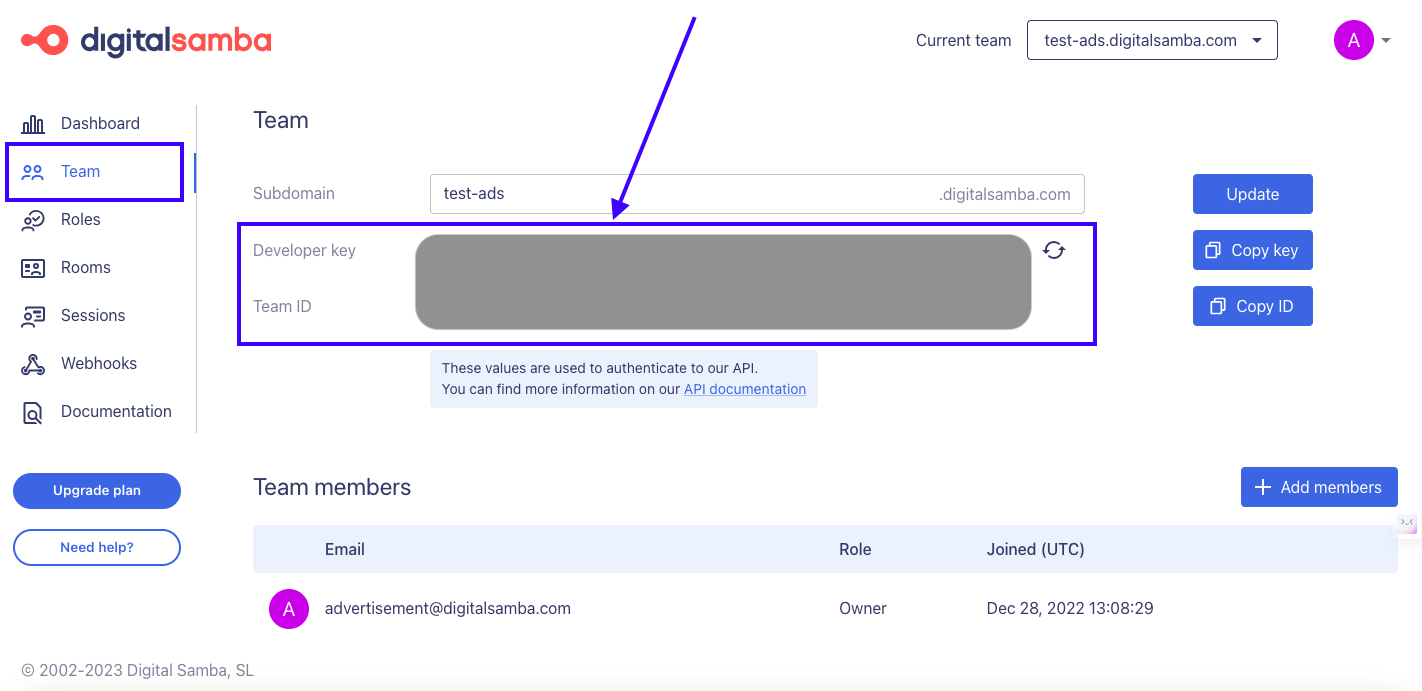
Let's look at how you can embed Digital Samba video conferencing on your website.
Understanding Digital Samba integration options
1. Using the Digital Samba API
The API is a versatile tool for developers, providing a programmatic interface to access and manage features like room creation, role assignment and statistics overview. This is suitable for those who require a high level of customisation and integration with other systems or third-party tools.
2. The HTML iframe embed
The simplest way to add a video conferencing room to your website is by embedding an HTML iframe snippet. This method requires minimal coding and is ideal for quick integrations. Here is an example of an iframe code snippet you can use:
This iframe embeds the video conferencing room into your website, enabling live video conferencing capabilities.
3. Digital Samba SDK
The SDK offers additional capabilities for more sophisticated integration. It allows developers to access in-room events and methods from frontend code, enabling deeper integration and customisation.
Creating a video conferencing room
You can create a room using the REST API or directly through the dashboard. The Digital Samba REST API involves executing a POST request to the /room endpoint with your Team ID and Developer Key. Here's an example of a POST request:
This request creates a room and sets its privacy state and available roles.
The privacy settings determine who can access the video conferencing room.
- Public: A public room is accessible to anyone with the link, allowing for broader participation without specific invitations.
- Private: A private room restricts access to only those explicitly invited or with the necessary credentials, ensuring a more controlled and secure environment.
Conversely, Roles define the level of access and control participants have in the room. Remember that a single moderator role is the simplest way to create a room.
- Moderator: Has the highest level of control, including managing participants and room settings.
- Speaker: Can actively participate and present in the room, with some controls over their segment of the session.
- Attendee: Generally has view-only access, with limited interaction capabilities, ideal for general participants in a larger audience.
The dashboard, on the other hand, provides a more visual and less technical method to accomplish the same task as illustrated below.
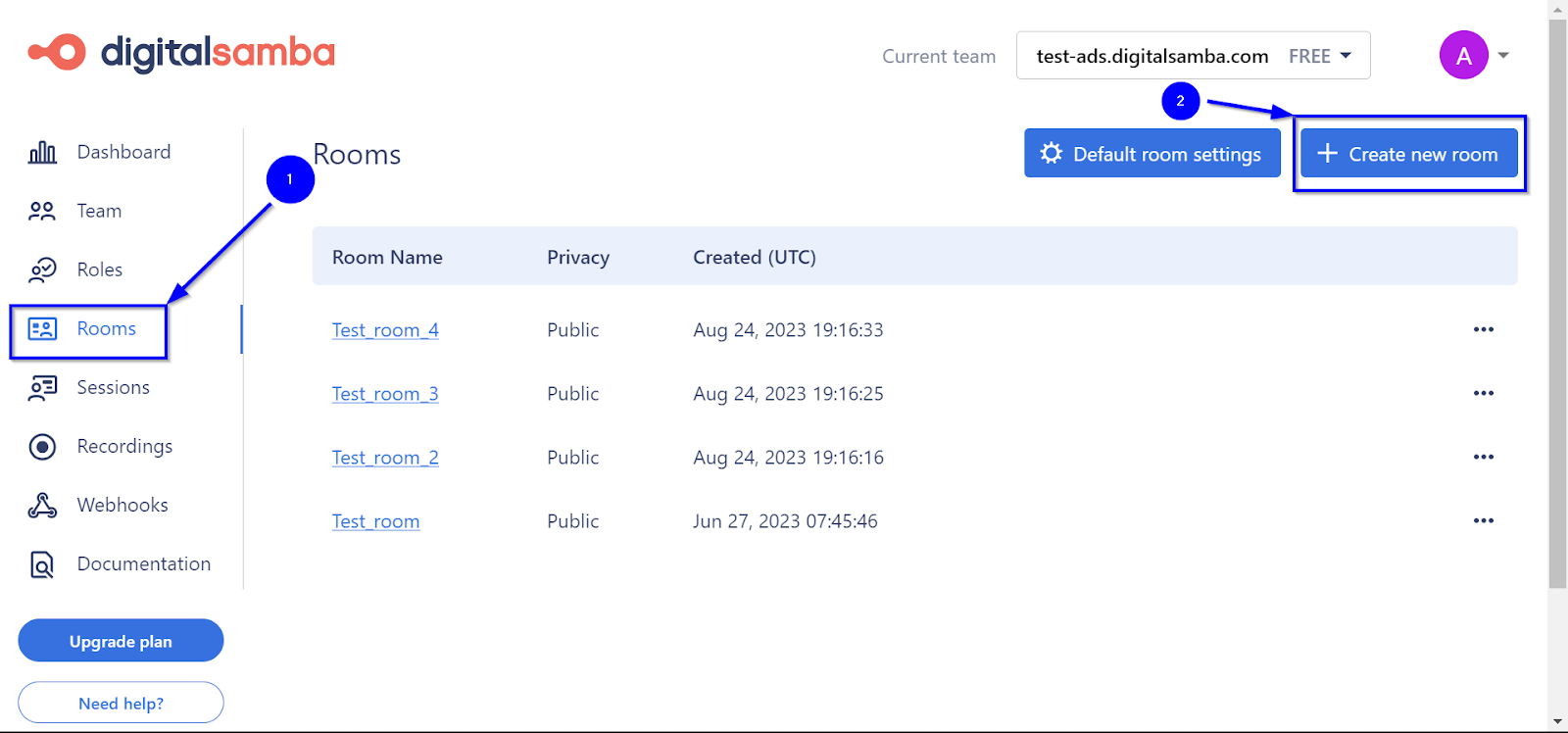
You will then be presented with the Create a new room window, where you can customise your room according to your preference.
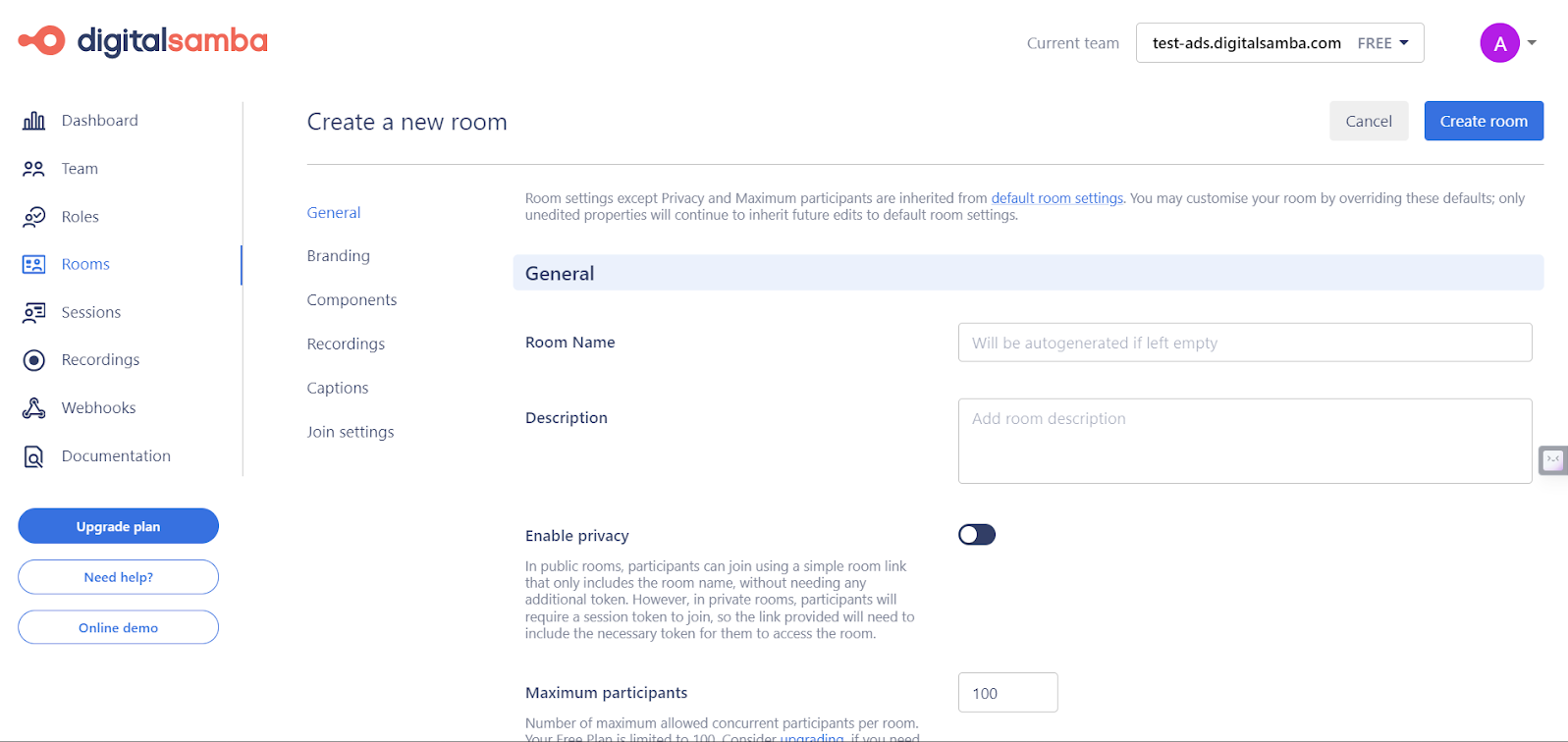
For more information on how to customise the embedded video conferencing experience using Digital Samba SDK, please visit this article: Easy Steps to Integrate Video Call on Your Website
Digital Samba Embedded WordPress plugin
The Digital Samba embedded WordPress plugin offers a seamless, no-code solution for integrating GDPR-compliant video conferencing and webinars into your website. With features like screen sharing, text chat, closed captioning, and virtual backgrounds, this plugin empowers you to enhance your online presence effortlessly.
How to use the plugin
Installation and setup:
- Install and activate the Digital Samba Embedded WordPress plugin on your WordPress website.
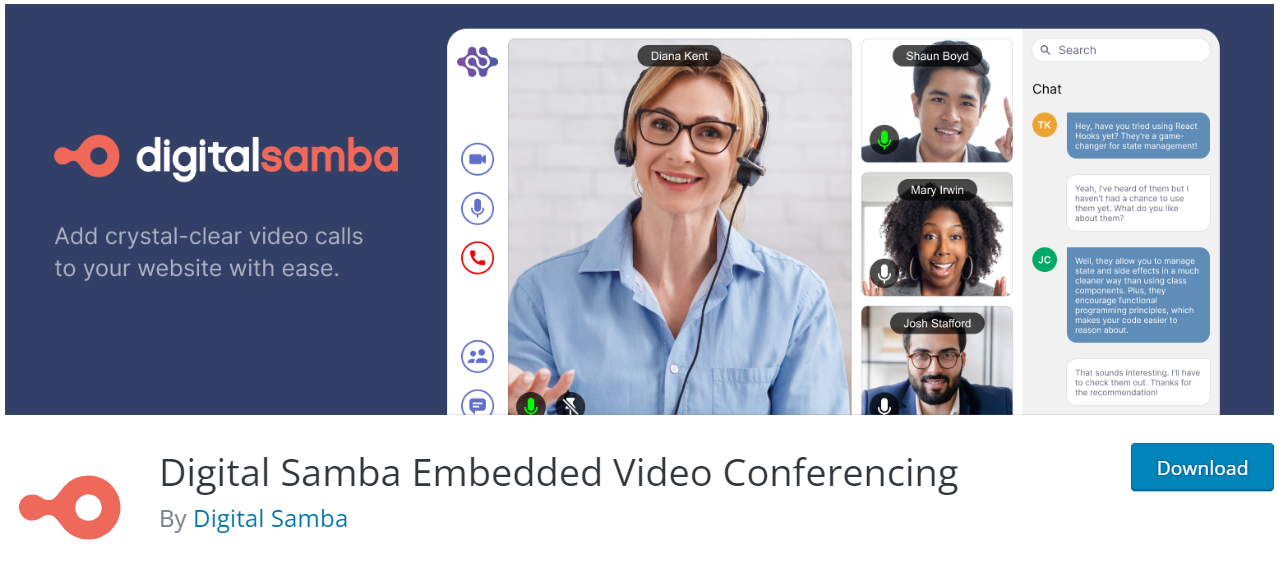
- Sign up for your free Digital Samba Embedded account to acquire your Developer Key and Team ID from Team tab.
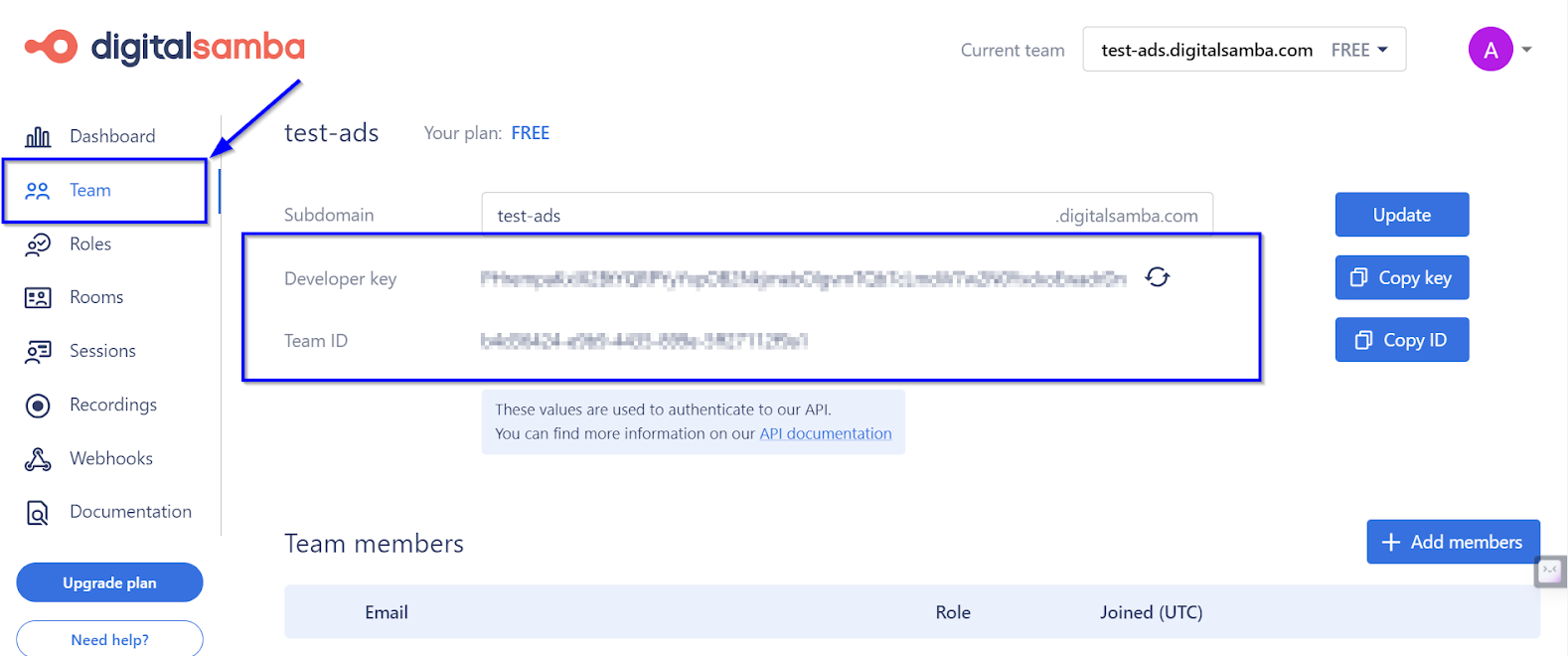
- Populate the plugin settings in WordPress with your Team ID, Domain & Developer Key.
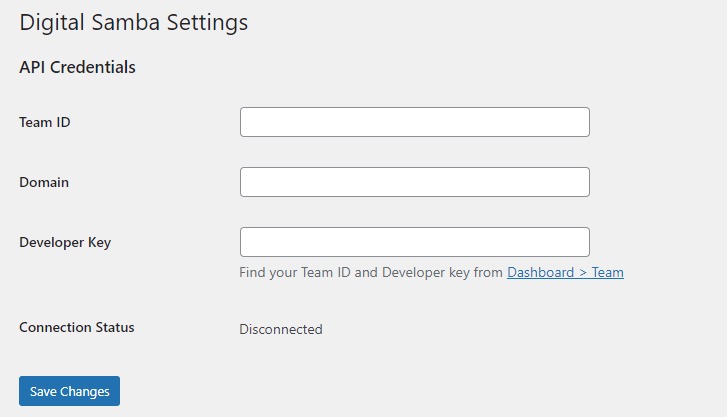
- Save your settings and confirm the connection to your Digital Samba Embedded account.
Creating a room:
- Access the Digital Samba Embedded WordPress plugin submenu and click Add New Room.
- Provide a title for the WordPress post for easy reference.
- Name your room within the plugin interface.
- Customise room colours and other parameters according to your design preference (helpful descriptions are available for each option).
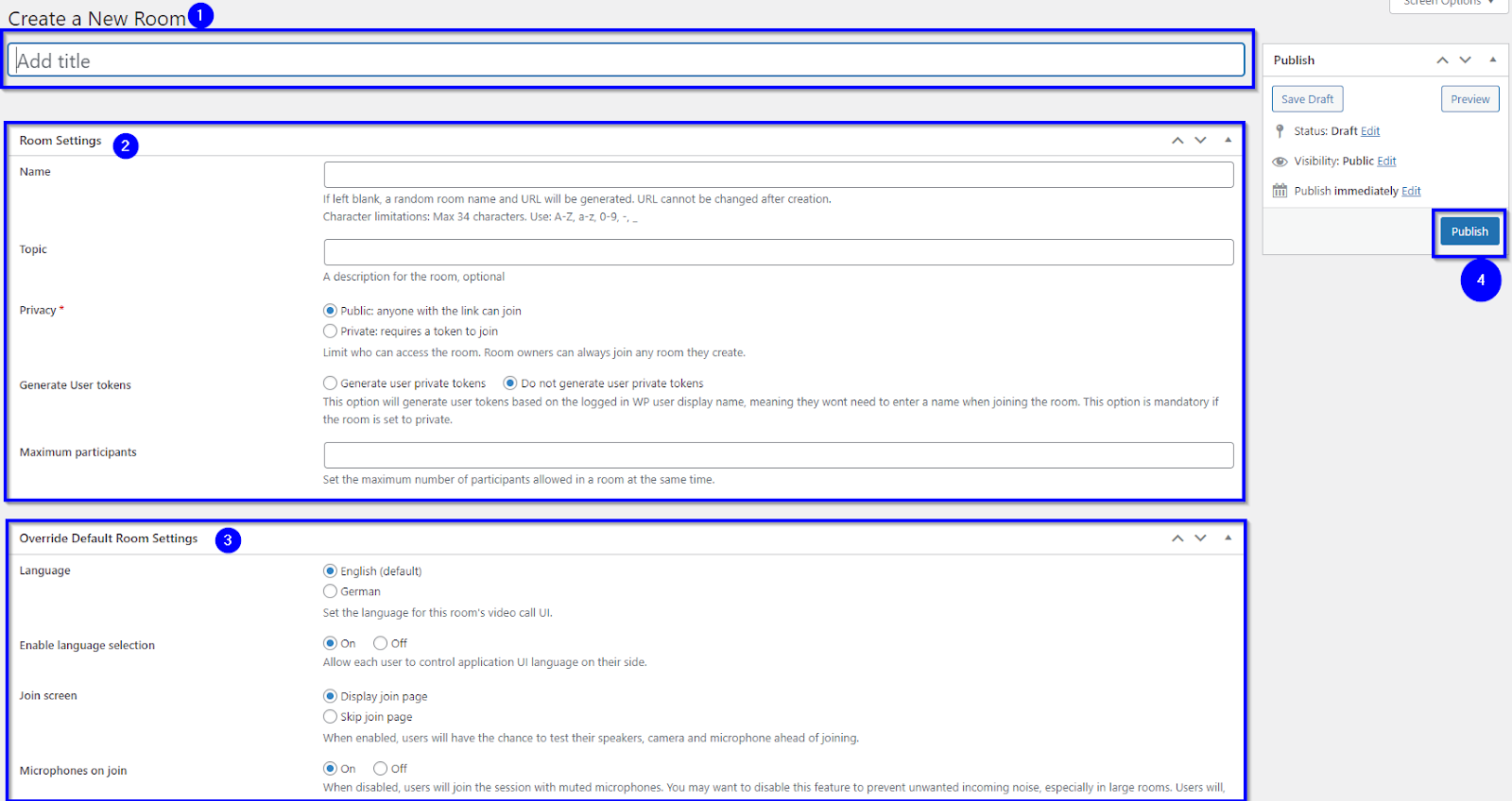
- Click Publish to create your room.
Embedding the room
- Upon creation, each room is equipped with a shortcode. Here is an example of what a room shortcode should look like:
- You can either use the room immediately via its permalink or embed it into other WordPress pages using the generated shortcode. Here is an example of a published room on the WordPress website.

- This flexibility allows you to control room visibility, whether for logged-in users or based on specific content restrictions. You can explore more on how to use shortcodes on the WordPress documentation.
Conclusion
Digital Samba video conferencing is built by developers for developers and is designed for seamless integration. If you need any assistance with implementation, our excellent support team will be happy to help. You can reach them by opening a support ticket here: https://www.digitalsamba.com/embedded-support.
We also offer integration services on demand. For a professional consultation and personalised offer, please get in touch with our sales team here: https://www.digitalsamba.com/contact-sales.
Share this
You May Also Like
These Related Stories

Easy Steps to Integrate Video Call on Your Website

How to configure your Digital Samba Rooms using developer API and SDK

